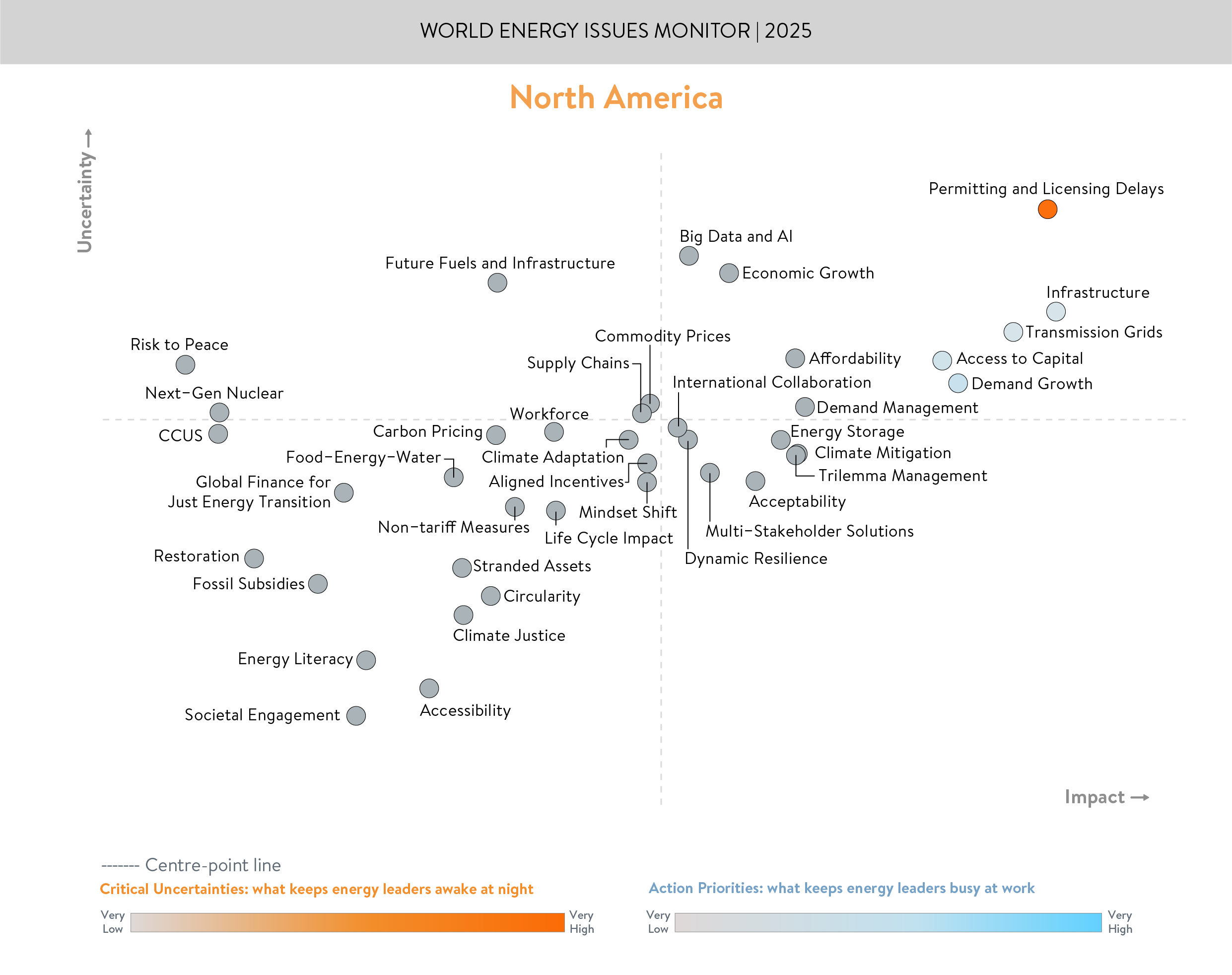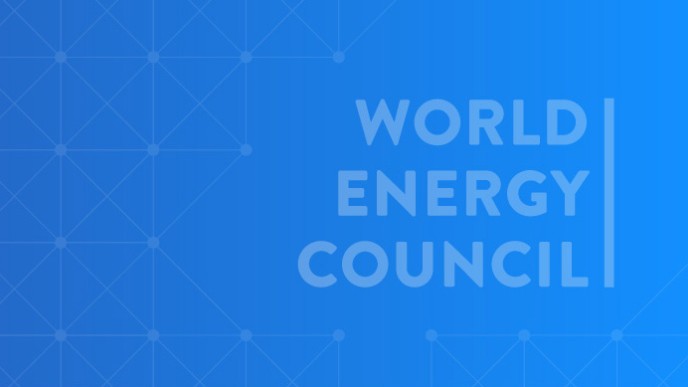North America Network
The North America region currently consists of Mexico and the United States of America. As significant energy producers and consumers, energy plays a critically important and highly valued part in the North American economies. The transition to clean energy therefore creates both large challenges and major opportunities which drive the region’s action priorities.
Regional action priorities that support the Council’s mission and humanising energy vision are agreed on an annual basis by national Member Committees in the framework of a Regional Action Plan. In 2021, key topics of interest to members included hydrogen as a key constituent in the future energy economy, advanced nuclear/SMR’s and transportation electrification needs and challenges.
The region has also addressed their countries’ unique issues and challenges at energy forums and workshops focusing on topics such as, replacement of nuclear, regulation on CCS technology, smart energy policies, energy efficiency with advanced technologies, and trade issues.
The region organises the World Energy Council official regional forum, the North America-Latin America bi-regional forum which addresses energy efficiency, energy conservation, alternative energies, energy transport and fossil fuels issues.
Energy in North America

INTRODUCTION
North America’s energy landscape is shaped by market-driven innovation, fragmented policies, and aging infrastructure. The region stands at a strategic crossroads — balancing the new energy dominance ambitions of U.S. with regional interdependencies and building momentum to address local and global environmental risks, from urban air pollution to climate change.
The U.S. leads in energy production and exports, with record shale and LNG growth reshaping domestic and global energy security. However, its ageing infrastructure requires $2.1 trillion in upgrades by 2050 to support grid modernization, meet AI-driven demand, and scale clean energy integration. Policy fragmentation across 50 state-level regulatory systems slows large-scale decarbonization. Meanwhile, affordability concerns persist, with US low-income households spending up to 8.6% of income on energy, compared to a 3% national average.
Canada’s focus is on clean electricity, with 83% of power from non-emitting sources. Nuclear expansion in Ontario and hydropower investments enhance reliability, while Indigenous-led energy projects drive equity. However, cross-border trade disputes and permitting delays hinder large-scale infrastructure projects.
Mexico faces a nearshoring-driven manufacturing boom, increasing power demand. The country’s reliance on U.S. natural gas imports (over 65% of supply) poses energy security risks, while efforts to expand wind and solar capacity are complicated by regulatory uncertainty. Industrial hubs like Querétaro are advancing localized renewable grids, but Mexico’s overall transition remains uneven.
The 2025 World Energy Issues Monitor reflects these diverse situations and connected dynamics, with infrastructure modernisation, AI and big data, and the resurgence of nuclear power emerging as top priorities. Crucial blind spots remain – including societal engagement, permitting hurdles, and workforce capacity.
As North America confronts intensifying climate pressures and political uncertainty, its energy future will hinge on the ability to integrate emerging technologies, strengthen collaboration, and build public trust. More stable policy frameworks with long-term perspectives, strengthened cross-border partnerships, and improved energy literacy opportunities will be essential to building energy systems that are more reliable, affordable and resilient.
|
ABOUT THE WORLD ENERGY ISSUES MONITOR Energy transitions are complex, evolving, and deeply interconnected, shaped by shifting priorities, emerging uncertainties, and regional realities. Since 2009, the World Energy Issues Monitor has offered a unique lens into the dynamic forces driving energy transitions worldwide. This year’s survey spans 39 core transition issues across six categories – spotlighting blind spots, new signals, and shifting leadership priorities. Amid growing uncertainty, leaders across the World Energy Council community are asking sharper questions: What’s working? What can be adapted across regions? And where are the real opportunities to turn blind spots into bright spots?
NOTE ON TIMING AND CONTEXT The world Energy Issues Monitor was conducted between 24 November 2024 and 10 January 2025. The regional workshops that informed the commentary insights took place in the second half of February 2025, before the current trade tensions and the US-led trade tariffs. As such, the regional commentaries should be read in the context in which they were developed, prior to the escalation of current global trade dynamics. |
CRITICAL UNCERTAINTIES AND ACTION PRIORITIES
Top Critical Uncertainty: Permitting & Licensing Delays
Lengthy reviews across jurisdictions delay expansions for high-voltage lines, new hydro or SMR deployments, and cross-border corridors, leading to unpredictable project timelines and inflated budgets.
-
Federal-State/Provincial Tensions: Proposed lines crossing multiple U.S. states or bridging Canadian provinces face overlapping jurisdictional checks. Similarly, new Mexican industrial enclaves rely on cross-border energy flows that may stall due to a lack of streamlined approvals.
-
Local Opposition: From pipeline expansions to solar developments on farmland, local groups often voice environmental or property rights concerns, calling for deeper engagement and transparent benefit-sharing.
-
Policy Fluctuation: Shifting political leadership in Washington, Ottawa, or Mexico City can alter or overhaul existing approval pathways, feeding uncertainty about whether newly proposed projects or advanced technologies will clear permitting hurdles.
Top Action Priority: Demand Growth
Electrified transport, nearshoring-driven manufacturing, and AI-powered digital infrastructure are rapidly increasing electricity demand. Managing this growth – while maintaining affordability and reliability – is a central challenge across the region.
-
EV Rollouts & Manufacturing: While California may continue to see increased EV uptake, growth across the U.S. remains highly uncertain due to rapidly evolving tax and regulatory changes – including shifts in federal funding to support EV adoption and infrastructure – while Canada’s automotive supply chain is investing in electric battery plants. Mexico’s pivot to nearshoring is attracting global manufacturers for stable and lower-carbon electricity supply.
-
Affordability vs. Reliability: Households already contend with inflation pressures, and many communities worry about surging electricity rates. Meanwhile, manufacturers demand stable, competitive pricing to sustain North America’s market edge.
-
Cross-Border Flows: Existing bilateral or trilateral energy deals – including U.S.-Canada power imports – could expand further to manage load fluctuations and mitigate cost concerns. However, progress depends on easing trade tensions and successfully navigating permitting hurdles.
|
Energy-Cyber Nexus – AI and Grid Resilience in North America
|
BLIND SPOTS AND BRIGHT SPOTS
Energy transitions allow certain sectors – like advanced storage or microgrids – to gain traction, while system-wide decarbonisation remains sporadic and hindered by contentious permitting and evolving political priorities across North America. A patchwork of local and national policies underscores varied progress. The 2025 data reveals:
Blind Spots
-
Societal Engagement & Energy Literacy
Large pipeline or grid expansions often falter due to local concerns; limited transparency over cost-benefit splits can inflame “not in my backyard” sentiments. This resonates especially in cross-border projects, such as Canada-U.S. cross-border lines or pipeline expansions.
-
Workforce Capacity
Aging skilled labour and insufficient recruits, especially for advanced analytics or high-voltage lines, slow modernisation. Mexico, driven by nearshoring expansions, also needs specialised talents for newly built industrial parks.
-
Climate Adaptation & Resilience
Despite repeated climate shocks – hurricanes, wildfires, and polar storms – resilience planning remains secondary to mitigation, leaving aging infrastructure increasingly exposed.
Bright Spots
-
Canada’s Nuclear & Transmission Update
Ontario’s move to expand nuclear capacity via small modular reactors (SMRs), plus interprovincial lines, aims to shrink diesel use in remote areas. Stable policy signals foster confidence in these low-carbon expansions.
-
Mexico’s Nearshoring & Renewable Grid Focus
Industrial growth in Querétaro has spurred new grid expansions. Coordinated federal-state plans explore wind and solar integration to meet surging loads, illustrating synergy between manufacturing corridors and cleaner energy pathways.
-
US-Canada Hydrogen Pilots
Cross-border hydrogen pilots signal early momentum in industrial decarbonisation, leveraging Canada’s production capacity with U.S. demand hubs.
|
Key Implications for Humanising Energy – North America
|
CONCLUSION
Just as watching a flock of birds can reveal evolving and seemingly chaotic patterns that ultimately follow a purposeful trajectory, North America’s energy transitions show a region poised between legacy infrastructures and emerging clean energy aspirations. This interplay highlights several important insights:
-
A Single Critical Uncertainty: Permitting and licensing delays ripple across jurisdictions, impacting everything from interconnectors to clean tech deployment, underscoring the need for streamlined, adaptive governance.
-
Demand Growth emerges as North America’s top Action Priority, with electrification of transport, AI-driven data centres, and nearshoring–fuelled manufacturing demanding reliable, affordable power.
-
Blind spots – from limited societal engagement to insufficient workforce development – undermine the best laid plans for grid modernisation and decarbonisation. Expanding the talent pipeline is as crucial as having robust policies in place.
-
Bright spots, including Canada’s nuclear expansions, Mexico’s nearshoring-driven renewables, and cross-border hydrogen pilots, show that collaborative projects can transcend shifting political climates.
Navigating these complexities calls for cohesive strategies that address infrastructure modernisation, humanise policy decisions, and harness the region’s vast technological capacity. The blending of local innovations with broader continental cooperation can favour North America’s progress toward a resilient and inclusive energy future that turns contrasting dynamics into forward momentum.
KEY CONTRIBUTORS:
In addition to thanking experts from across our community for their contributions, we would like to make special mention of Guillaume Bence-Hébert, Senior Consultant at Trama TecnoAmbiental; Rachel Melton, Operations Compliance and Analysis Lead at California ISO and Member of the Future Energy Leader Board at the World Energy Council; Akshay Patil, Manager, Data Science at Bain & Company and Future Energy Leader at the World Energy Council; and Sandra Winkler, Senior Director, Insights at the World Energy Council.
Downloads

World Energy Issues Monitor 2025
Download PDF
World Energy Issues Monitor 2025 - North America Regional Commentary
Download PDF
As part of World Energy Week LIVE 2021, a conversation focusing on Turning points in the global e-mobility transition was convened. Participants engaged in a dialogue about the electrification of transportation and how it is accelerating on many fronts globally, driven by national policies and enabled by rapidly evolving technologies and decreasing costs. As part of the discussion, they highlighted the importance for both national and community stakeholders to clearly understand the pace of change within the transportation sector and to develop strategies and programs to remove obstacles to the adoption of electric vehicle technologies. As part of the conversation participants encouraged stakeholders involved to consider what the key technology issues are that must be addressed to ensure that the global e-mobility transition meets its objectives, what steps economies as well as impacted communities can take to ensure that their residents can fully participate in the environmental and economic benefits of e-mobility, and shared lessons learned from North America that can offer guidance to other countries and communities in their own e-mobility transition.





